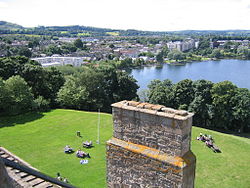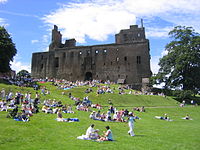Linlithgow: Difference between revisions
Created page with '{{Infobox town |name= Linlithgow |county = West Lothian |picture=Am linlithgow palace and town.JPG |picture caption=Linlithgow from Linlithgow Palace |population= 13,370 |os gri…' |
No edit summary |
||
| Line 14: | Line 14: | ||
|dialling code= 01506 | |dialling code= 01506 | ||
}} | }} | ||
'''Linlithgow''' is a royal burgh | '''Linlithgow''' is a royal burgh and county town of [[West Lothian]], which county is also known as "Linlithgowshire". | ||
The chief historic attraction of Linlithgow is the remains of Linlithgow Palace, the birthplace of King James V and Mary, Queen of Scots, and probably Scotland's finest surviving late medieval secular building. The present Palace was started (on an older site) in 1424 by James I of Scotland. It was burnt in 1746, and while unroofed is still largely complete although very few of the original furnishings survived. | The chief historic attraction of Linlithgow is the remains of Linlithgow Palace, the birthplace of King James V and Mary, Queen of Scots, and probably Scotland's finest surviving late medieval secular building. The present Palace was started (on an older site) in 1424 by James I of Scotland. It was burnt in 1746, and while unroofed is still largely complete although very few of the original furnishings survived. | ||
Revision as of 15:53, 16 November 2010
| Linlithgow | |
| West Lothian | |
|---|---|
 Linlithgow from Linlithgow Palace | |
| Location | |
| Grid reference: | NS996774 |
| Location: | 55°58’45"N, 3°36’38"W |
| Data | |
| Population: | 13,370 |
| Post town: | Linlithgow |
| Postcode: | EH49 |
| Dialling code: | 01506 |
| Local Government | |
| Council: | West Lothian |
| Parliamentary constituency: |
Linlithgow and East Falkirk |
Linlithgow is a royal burgh and county town of West Lothian, which county is also known as "Linlithgowshire".
The chief historic attraction of Linlithgow is the remains of Linlithgow Palace, the birthplace of King James V and Mary, Queen of Scots, and probably Scotland's finest surviving late medieval secular building. The present Palace was started (on an older site) in 1424 by James I of Scotland. It was burnt in 1746, and while unroofed is still largely complete although very few of the original furnishings survived.
The town
The town has a generally east-west orientation and is centred on what used to be the main Edinburgh-Stirling road; this now forms the main thoroughfare called the High Street. Plots of farmed land, known as rigs, ran perpendicular to the High Street and comprised much of the town's development until the 19th century. Growth was restricted to the north by Linlithgow Loch, and by the steep hill to the south, but, in the late 19th & early 20th centuries, development began to take place much further south of the High Street. In the late 20th century, demand for housing saw many residential developments take place much further south, as well as spreading into new areas. This southward development was bisected by the Union Canal and latterly the main Edinburgh-Glasgow railway line, and today the limited crossings of both cause problems with modern traffic as there are only three places where each can be crossed in the town.
To the west, Linlithgow Bridge used to be a somewhat distinct village with its own identity, but in the latter half of the 20th century it was enveloped in the expansion of the main town and today the distinction between them is hard to make out.
Development
Two large tracts of the northern side of the High Street were demolished in the 1960s and replaced by flats and public buildings in a modernist style. Although these buildings were no doubt welcomed at the time as being a vast improvement on what must have been cramped and dilapidated traditional accommodation, they were poorly conceived and constructed and have required extensive maintenance and renovation over the years, and the 1960s building have imposed a brutal effect on the character and appearance of the town's main thoroughfare.
Today the town is especially popular with middle classes and commuters, not only because of its excellent transport links with Edinburgh, Glasgow and Stirling, but also because of the perceived quality of its schooling. Its size grew considerably during the 1990s with the completion of several housing developments on the east side of the town. There is little scope for the town to grow further as it is now bounded by green belt to the south and east, the M9 to the north, the river Avon to the West and with the east side of the town having limited access to the M9.
Sights of the town

The 15th century St. Michael's Church is the most complete surviving example of a large late medieval 'burgh kirk' in Scotland. Its western tower originally had a distinctive stone crown spire, of the type seen also on the High Kirk of St Giles in Edinburgh, or on Newcastle Cathedral, which was removed in the early 19th century. In 1964 a replacement spire was erected, controversially in aluminium and in a modern style, representing Christ's crown of thorns.
James Hamilton of Bothwellhaugh carried out the first assassination with a firearm, when he shot James Stewart, 1st Earl of Moray, the regent of Scotland, on 11 January 1570 in Linlithgow.
Churches
- Church of Scotland:
- St Michael's Parish Church
- St Ninian's, Craigmailen
- Methodist chapel, now an evangelical church, St Johns,[1] which meets in Linlithgow Academy on a Sunday morning)
- Scottish Episcopal Church
- Roman Catholic: St Michael's, which was used as an ambulance depot by Polish servicemen during the Second World War.[1]
Arms

The town's coat of arms features a black bitch dog against an oak tree which grows on an island. Linlithgow's patron saint is Saint Michael and its motto is St. Michael is kinde to strangers.
The arms come from a legend of a black greyhound whose master was sentenced to starve to death on an island in Linlithgow Loch. She used to swim from the town every day with food for him, and managed to save his life. The townspeople took the symbol of the dog's loyalty and bravery as their own. The local pub named "The Black Bitch" is one of Scotland's oldest pubs.[2]
Events
The Riding of the Marches, held in one form or another since the mid-16th century and nowadays celebrated on the first Tuesday after the second Thursday in June, involve young and old in the tradition of checking the burgh's perimeter, including the town's historic port of Blackness. Although today's activities are centred more on the colourful parades through the town that involve bands and floats decorated by local groups, the more ceremonial duties of the Marches are still adhered to and a variety of local groups ensure that the traditions, old and new, are maintained.
There are many other events during the year such as the Children's Gala Day,[3] the Linlithgow Folk Festival and a pre-Christmas Victorian Street Fayre, and the sense of community is enhanced by many active local groups such as Linlithgow Amateur Musical Productions (LAMP) [2], Lithca Lore, The Linlithgow Players [3] and The 41 Club.
The Linlithgow Union Canal Society run a canal museum and operate narrowboat tours from Manse Road basin.[4]
References
- ↑ "1ST MOTOR AMBULANCE CONVOY - The story of a Polish ambulance unit stationed in the historic burgh of Linlithgow". 1st-mac.com. http://www.1st-mac.com/. Retrieved 2009-04-30.
- ↑ Grant Stott (9 March 2007). "What! Mr Scott was Black Bitch? - Scotsman.com News". The Scotsman. http://news.scotsman.com/grantstott/What-Mr-Scott-was-Black.3353034.jp. Retrieved 2009-03-24.
- ↑ "Linlithgow & Linlithgow Bridge Children's Gala Day". http://www.linlithgowgala.co.uk/. Retrieved 2008-04-08.
- ↑ "Linlithgow Canal Centre". http://www.lucs.org.uk/. Retrieved 2008-04-08.